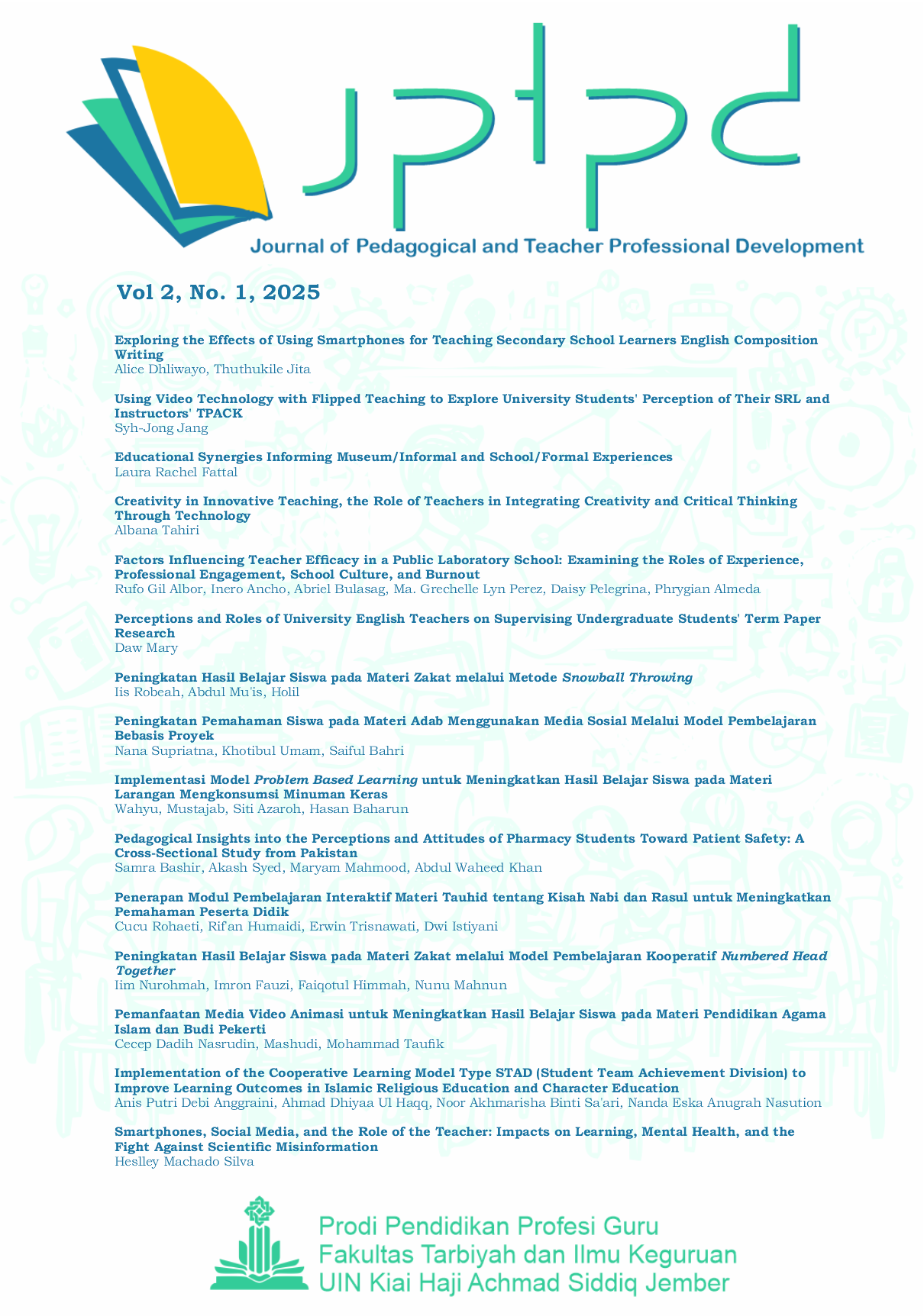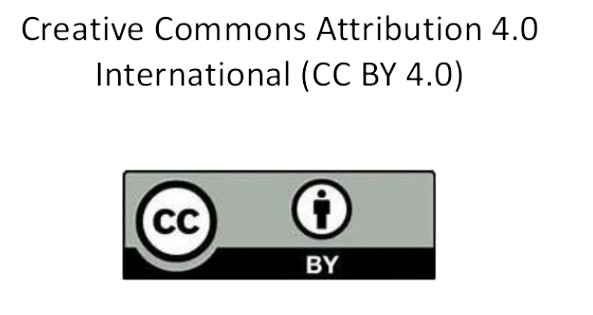Factors Influencing Teacher Efficacy in a Public Laboratory School: Examining the Roles of Experience, Professional Engagement, School Culture, and Burnout
DOI:
https://doi.org/10.35719/jptpd.v2i1.968Keywords:
Teacher Efficacy, School Culture, Burnout, Professional Engagement, Public Laboratory School, Faculty DevelopmentAbstract
Teacher efficacy is a critical determinant of instructional effectiveness and student outcomes, particularly in laboratory schools that serve as training hubs for educators. This study examines the factors influencing teacher efficacy in a public laboratory school, focusing on experience, professional engagement, school culture, and burnout. Using a survey research design, data were collected from 36 faculty members through structured questionnaires measuring teacher efficacy, school culture, and burnout levels. Pearson correlation and regression analysis were employed to assess the relationships among key variables. Findings indicate that perceived school culture has a significant, positive, moderate correlation with teacher efficacy, explaining 44% of its variance. Conversely, teacher burnout exhibits a significant, negative, moderate correlation with teacher efficacy, accounting for 18% of its variance. In contrast, teacher efficacy showed no significant correlation with length of service, educational attainment, research engagement, or extension involvement. These results suggest that institutional factors such as school culture and workload management play a more crucial role in shaping teacher efficacy than individual professional attributes. The study highlights the need for policies that foster a supportive school environment, reduce burnout risk, and integrate professional development initiatives to enhance teacher confidence and effectiveness.
References
Abun, D., Asuncion, S. B., Lazaro, J. R., Magallanes, T., & Nimfa, C. C. (2021). The effect of educational attainment, length of work experience on the self-efficacy of teachers and employees. International Journal of Business Ecosystem & Strategy, 3(2), 16–28. https://dx.doi.org/10.2139/ssrn.3954135
Anderson, S. L., & Betz, N. E. (2001). Sources of social self-efficacy expectations: Their measurement and relation to career development. Journal of Vocational Behavior, 58, 98–117. https://doi.org/10.1006/jvbe.2000.1753
Armor, D., Conroy-Osequera, P., Cox, M., King, N., McDonnel, L., Pascal, A., Pauley, E., & Zellman, G. (1976). Analysis of the school preferred reading programs in selected Los Angeles minority schools (R-2007-LAUSD). Rand.
Aronson, J. (1994). A pragmatic view of thematic analysis. The Qualitative Report, 2(1). http://www.nova.edu/ssss/QR/BackIssues/QR2-1/aronson.html
Ashton, P. (1984). Teacher efficacy: A motivational paradigm for effective teacher education. Journal of Teacher Education, 35(5), 28–32. https://doi.org/10.1177/002248718403500507
Ashton, P. T., & Webb, R. B. (1986). Making a difference: Teachers' sense of efficacy and student achievement. Longman Publishing Group.
Bandura, A. (1977). Self-efficacy: Toward a unifying theory of behavioral change. Psychological Review, 84(2), 191–215. https://psycnet.apa.org/doi/10.1037/0033-295X.84.2.191
Bandura, A. (1986). The explanatory and predictive scope of self-efficacy theory. Journal of Social and Clinical Psychology, 4(3), 359–373. https://psycnet.apa.org/doi/10.1521/jscp.1986.4.3.359
Bandura, A. (1993). Perceived self-efficacy in cognitive development and functioning. Educational Psychologist, 28(2), 117–148. https://doi.org/10.1207/s15326985ep2802_3
Bandura, A. (1997). Self-efficacy: The exercise of control. Macmillan.
Bandura, A. (2006). Bandura’s instrument teacher self-efficacy scale.
Bazeley, P. (2010). Conceptualizing research performance. Studies in Higher Education, 35(8), 889–903. https://doi.org/10.1080/03075070903348404
Bentley, P. J., & Kyvik, S. (2013). Academic work from a comparative perspective: A survey of faculty working time across 13 countries. Higher Education, 66, 329–345. https://doi.org/10.1007/s10734-012-9595-6
Berman, P., & McLaughlin, M. (1977). Federal programs supporting educational change (Vol. 3: Factors affecting implementation and continuation) (Report No. R-158917-HEW). The Rand Corporation.
Bobbett, J. (2001). School culture, teacher efficacy, and decision making in demonstrably effective and ineffective schools (Doctoral dissertation, Louisiana State University).
Bolman, L. G., & Deal, T. E. (1997). Reframing organizations: Artistry, choice, and leadership. Jossey-Bass.
Bosscher, R. J., & Smit, J. H. (1998). Confirmatory factor analysis of the general self-efficacy scale. Behaviour Research and Therapy, 36(3), 339–343. https://doi.org/10.1016/s0005-7967(98)00025-4
Bozkurt, S., Çoban, Ö., Özdemir, M., & Özdemir, N. (2021). How leadership, school culture, collective efficacy, academic self-efficacy, and socioeconomic status affect student achievement. Egitim ve Bilim, 46(207). https://doi.org/10.15390/EB.2021.9338
Brill, S., & McCartney, A. (2008). Stopping the revolving door: Increasing teacher retention. Politics & Policy, 36(5), 750–774. https://doi.org/10.1111/j.1747-1346.2008.00133.x
Brinson, D., & Steiner, L. (2007). Building collective efficacy: How leaders inspire teachers to achieve. Center for Comprehensive School Reform and Improvement.
Brouwers, A., & Tomic, W. (2000). A longitudinal study of teacher burnout and perceived self-efficacy in classroom management. Teaching and Teacher Education, 16(2), 239–253. https://doi.org/10.1016/S0742-051X(99)00057-8
Bryman, A. (2016). Social research methods. Oxford university press.
Burley, W. W., Hall, B. W., Villeme, M. G., & Brockmeier, L. L. (1991, April). A path analysis of the mediating role of efficacy in first-year teachers’ experiences, reactions, and plans. Annual Meeting of the American Educational Research Association, Chicago, IL.
Cabaroglu, N. (2014). Professional development through action research: Impact on self-efficacy. System, 44, 79–88. https://doi.org/10.1016/j.system.2014.03.003
Calice, M. N., Beets, B., Bao, L., Scheufele, D. A., Freiling, I., Brossard, D., ... & Handelsman, J. (2022). Public engagement: Faculty lived experiences and perspectives underscore barriers and a changing culture in academia. PLOS One, 17(6), e0269949. https://doi.org/10.1371/journal.pone.0269949
Caprara, G. V., Barbaranelli, C., Steca, P., & Malone, P. S. (2006). Teachers' self-efficacy beliefs as determinants of job satisfaction and students' academic achievement: A study at the school level. Journal of School Psychology, 44(6), 473–490. https://doi.org/10.1016/j.jsp.2006.09.001
Carter, W. R., Nesbit, P. L., Badham, R. J., Parker, S. K., & Sung, L. K. (2018). The effects of employee engagement and self-efficacy on job performance: A longitudinal field study. The International Journal of Human Resource Management, 29(17), 2483–2502. http://dx.doi.org/10.1080/09585192.2016.1244096
Chemers, M. M., Watson, C. B., & May, S. T. (2000). Dispositional affect and leadership effectiveness: A comparison of self-esteem, optimism, and efficacy. Personality and Social Psychology Bulletin, 26(3), 267–277. https://psycnet.apa.org/doi/10.1177/0146167200265001
Chesnut, S. R., & Burley, H. (2015). Self-efficacy as a predictor of commitment to the teaching profession: A meta-analysis. Educational Research Review, 15, 1–16. https://doi.org/10.1016/j.edurev.2015.02.001
Coladarci, T. (1992). Teacher’s sense of efficacy and commitment to teaching. The Journal of Experimental Education, 60(4), 323–337. http://dx.doi.org/10.1080/00220973.1992.9943869
Collie, R. J., Shapka, J. D., & Perry, N. E. (2011). Predicting teacher commitment: The impact of school climate and social-emotional learning. Psychology in the Schools, 48(10), 1034–1048. https://doi.org/10.1002/pits.20611
Collie, R. J., Shapka, J. D., & Perry, N. E. (2015). School climate and social-emotional learning: Predicting teacher stress, job satisfaction, and teaching efficacy. Journal of Educational Psychology, 107(4), 1189–1204. https://doi.org/10.1037/edu0000108
Creswell, J. W., & Creswell, J. D. (2018). Research design: Qualitative, quantitative, and mixed methods approaches (5th ed.). SAGE Publications.
Darling-Hammond, L. (2017). Effective teacher professional development. Learning Policy Institute.
Dembo, M. H., & Gibson, S. (1985). Teachers' sense of efficacy: An important factor in school improvement. The Elementary School Journal, 86(2), 173–184.
Dexter, C. A., & Wall, M. (2021). Reflective functioning and teacher burnout: The mediating role of self-efficacy. Reflective Practice, 22(6), 753–765.
Dibapile, W. T. S. (2012). A review of literature on teacher efficacy and classroom management. Journal of College Teaching & Learning (Online), 9(2), 79. https://doi.org/10.19030/tlc.v9i2.6902
Dillman, D. A., Smyth, J. D., & Christian, L. M. (2014). Internet, phone, mail, and mixed-mode surveys: The tailored design method (4th ed.). Wiley.
Donovan, M. S., Bransford, J. D., & Pellegrino, J. W. (1999). How people learn: Bridging research and practice. National Academy Press.
Donohoo, J., Hattie, J., & Eells, R. (2018). The power of collective efficacy. Educational Leadership, 75(6), 40–44. https://eric.ed.gov/?id=EJ1171558
Dunn, R. J., & Harris, L. G. (1998). Organizational dimensions of climate and the impact on school achievement. Journal of Instructional Psychology, 25(2), 100. https://www.proquest.com/openview/4adf58e88cd2e7301a4d54bf5f3f744f/1?cbl=2029838&pq-origsite=gscholar
Edgerson, D. E., Kritsonis, W. A., & Herrington, D. (2006). The Critical Role of the Teacher-Principal Relationship in the Improvement of Student Achievement in Public Schools of the United States. Online Submission, 3. https://eric.ed.gov/?id=ED491985
Evers, W. J., Brouwers, A., & Tomic, W. (2002). Burnout and self-efficacy: A study on teachers’ beliefs when implementing an innovative educational system in the Netherlands. British Journal of Educational Psychology, 72, 227–243. http://dx.doi.org/10.1348/000709902158865
Fackler, S., & Malmberg, L. E. (2016). Teachers' self-efficacy in 14 OECD countries: Teacher, student group, school and leadership effects. Teaching and teacher education, 56, 185-195. https://doi.org/10.1016/j.tate.2016.03.002
Fives, H., Hamman, D., & Olivarez, A. (2007). Does burnout begin with student-teaching? Analyzing efficacy, burnout, and support during the student-teaching semester. Teaching and Teacher Education, 23(6), 916–934. https://doi.org/10.1016/j.tate.2006.03.013
Fowler, F. J. (2014). Survey research methods (5th ed.). SAGE Publications.
Fullan, M. G., & Hargreaves, A. (1991). What's worth fighting for? Working together for your school. The Regional Laboratory for Educational Improvement of the Northeast & Islands, 300 Brickstone Square, Suite 900, Andover, MA 01810 (Order no. 9117-09, $13.00 plus $2.50 shipping and handling; quantity discounts).
Gagnon, N., & Dubeau, A. (2023). Building and maintaining self-efficacy beliefs: A study of entry-level vocational education and training teachers. Vocations and Learning, 16(3), 511–532. https://doi.org/10.1007/s12186-023-09326-x
Gale, J., Alemdar, M., Cappelli, C., & Morris, D. (2021, September). A mixed methods study of self-efficacy, the sources of self-efficacy, and teaching experience. Frontiers in Education, 6, 750599. https://doi.org/10.3389/feduc.2021.750599
Gist, M. E., & Mitchell, T. R. (1992). Self-efficacy: A theoretical analysis of its determinants and malleability. Academy of Management review, 17(2), 183-211.
Goddard, R. D., Hoy, W. K., & Woolfolk, A. (2000). Collective Teacher Efficacy: Its Meaning, Measure, and Effect on Student Achievement. American Education Research Journal, 37, 479-507.
https://doi.org/10.3102/00028312037002479
Gratacós, G., Mena, J., & Ciesielkiewicz, M. (2023). The complexity thinking approach: Beginning teacher resilience and perceived self-efficacy as determining variables in the induction phase. European Journal of Teacher Education, 46(2), 331–348.
Groves, R. M., Fowler, F. J., Couper, M. P., Lepkowski, J. M., Singer, E., & Tourangeau, R. (2009). Survey methodology (2nd ed.). Wiley.
Gu, Q., & Day, C. (2007). Teachers resilience: A necessary condition for effectiveness. Teaching and Teacher education, 23(8), 1302-1316. https://doi.org/10.1016/j.tate.2006.06.006
Harrison, M. G., King, R. B., & Wang, H. (2023). Satisfied teachers are good teachers: The association between teacher job satisfaction and instructional quality. British Educational Research Journal, 49(3), 476–498. https://doi.org/10.1002/berj.3851
Hemmings, B., & Kay, R. (2010). Prior achievement, effort, and mathematics attitude as predictors of current achievement. The Australian Educational Researcher, 37(2), 41-58. https://doi.org/10.1007/BF03216921
Hoy, A. W. (2000) Changes in teacher efficacy during the early years of teaching. Paper presented at the Annual Meeting of the American Educational Research Association, New Orleans.
Ismayilova, K. (2018). University teachers’ self-efficacy for research and teaching and its relationship with their job satisfaction (Doctoral dissertation, University of York).
Klassen, R. M., & Tze, V. M. (2014). Teachers’ self-efficacy, personality, and teaching effectiveness: A meta-analysis. Educational Research Review, 12, 59–76. https://doi.org/10.1016/j.edurev.2014.06.001
Leithwood, K., & Jantzi, D. (2005). Transformational leadership. The essentials of school leadership, 31, 43. https://www.torrossa.com/en/resources/an/4913596#page=54
Li, S. (2023). The effect of teacher self-efficacy, teacher resilience, and emotion regulation on teacher burnout: A mediation model. Frontiers in Psychology, 14, 1185079. https://doi.org/10.3389/fpsyg.2023.1185079
Li, R., Liu, H., Chen, Y., & Yao, M. (2022). Teacher engagement and self-efficacy: The mediating role of continuing professional development and moderating role of teaching experience. Current Psychology, 41(1), 328–337. https://link.springer.com/article/10.1007/s12144-019-00575-5
Lin, W., Yin, H., & Liu, Z. (2022). The roles of transformational leadership and growth mindset in teacher professional development: The mediation of teacher self-efficacy. Sustainability, 14(11), 6489. https://doi.org/10.3390/su14116489
Liu, Y., Bellibaş, M. Ş., & Gümüş, S. (2021). The effect of instructional leadership and distributed leadership on teacher self-efficacy and job satisfaction: Mediating roles of supportive school culture and teacher collaboration. Educational Management Administration & Leadership, 49(3), 430–453. https://doi.org/10.1177/1741143220910438
Lortie D. C. (2002). Schoolteacher : A sociological study (2nd ed.). Chicago: University of Chicago Press.
Malinen, O. P., & Savolainen, H. (2016). The effect of perceived school climate and teacher efficacy in behavior management on job satisfaction and burnout: A longitudinal study. Teaching and teacher education, 60, 144-152. https://doi.org/10.1016/j.tate.2016.08.012
Marsh, H. W., & Hattie, J. (2002). The relation between research productivity and teaching effectiveness: Complementary, antagonistic, or independent constructs?. The journal of higher education, 73(5), 603-641. https://doi.org/10.1080/00221546.2002.11777170
McCormick, M. J. (2001). Self-efficacy and leadership effectiveness: Applying social cognitive theory to leadership. Journal of leadership studies, 8(1), 22-33. https://doi.org/10.1177/107179190100800102
McLean, N., & Price, L. (2019). Identity formation among novice academic teachers–a longitudinal study. Studies in higher education, 44(6), 990-1003. https://doi.org/10.1080/03075079.2017.1405254
McLeod, J. D., Uemura, R., & Rohrman, S. (2012). Adolescent mental health, behavior problems, and academic achievement. Journal of health and social behavior, 53(4), 482-497. https://doi.org/10.1177/0022146512462888
Min, M. (2023). School culture, self-efficacy, outcome expectation, and teacher agency toward reform with curricular autonomy in South Korea: A social cognitive approach. Asia Pacific Journal of Education, 43(4), 951-967. https://doi.org/10.1080/02188791.2019.1626218
Minett, R. (2015). A qualitative study investigating the sources of teacher efficacy beliefs (Doctoral dissertation, University of East Anglia). https://ueaeprints.uea.ac.uk/id/eprint/56883/
O’Meara, K., Sandmann, L. R., Saltmarsh, J., & Giles, D. E. (2011). Studying the professional lives and work of faculty involved in community engagement. Innovative Higher Education, 36, 83-96. https://doi.org/10.1007/s10755-010-9159-3
Ozturk, O. (2021). Bibliometric review of resource dependence theory literature: an overview. Management Review Quarterly, 71(3), 525-552. https://doi.org/10.1007/s11301-020-00192-8
Pas, E. T., Bradshaw, C. P., & Hershfeldt, P. A. (2012). Teacher-and school-level predictors of teacher efficacy and burnout: Identifying potential areas for support. Journal of school Psychology, 50(1), 129-145. https://doi.org/10.1016/j.jsp.2011.07.003
Penrose, A., Perry, M. C., & Ball, I. (2007). Emotional intelligence and teacher self efficacy: The contribution of teacher status and length of experience. http://www.iier.org.au/iier17/penrose.html
Richmond, V. P., Wrench, J. C., & Gorham, J. (2001). Communication, affect, and learning in the classroom. Acton, MA: Tapestry Press.
Rouse, K. W. (2021). Influential factors of school culture on teacher self-efficacy and motivation: An ethnographic case study (Doctoral dissertation, University of South Carolina).
Schaufeli, W. B., & Bakker, A. B. (2004). Job demands, job resources, and their relationship with burnout and engagement: A multi‐sample study. Journal of Organizational Behavior: The International Journal of Industrial, Occupational and Organizational Psychology and Behavior, 25(3), 293-315. https://doi.org/10.1002/job.248
Scherer, K. R. (2021). Evidence for the existence of emotion dispositions and the effects of appraisal bias. Emotion, 21(6), 1224. https://psycnet.apa.org/doi/10.1037/emo0000861
Skaalvik, E. M., & Skaalvik, S. (2019). Teacher self-efficacy and collective teacher efficacy: Relations with perceived job resources and job demands, feeling of belonging, and teacher engagement. Creative Education, 10(7), 1400–1424. https://doi.org/10.4236/ce.2019.107104
Stajkovic, A. D., & Luthans, F. R. E. D. (2000). The Diferential Engagement and Relative Effects of Incentive Motivators on Work Performance. Academy of Management Journal.
Thapa, A., Cohen, J., Guffey, S., & Higgins-D’Alessandro, A. (2013). A review of school climate research. Review of educational research, 83(3), 357-385. https://doi.org/10.3102/0034654313483907
Tschannen-Moran, M., & Hoy, A. W. (2001). Teacher efficacy: Capturing an elusive construct. Teaching and Teacher Education, 17(7), 783–805. https://doi.org/10.1016/S0742-051X(01)00036-1
Vaccaro, N. (2009). The relationship between research self-efficacy, perceptions of the Research training environment and interest in research in Counselor education doctoral students: an ex-post-facto, Cross-sectional correlation investigation.
Wagner, C. R. (2006). The school leader’s tool for assessing and improving school culture. Principal Leadership, 7(4), 41-44. https://eric.ed.gov/?id=EJ767851
Wray, E., Sharma, U., & Subban, P. (2022). Factors influencing teacher self-efficacy for inclusive education: A systematic literature review. Teaching and Teacher Education, 117, 103800. https://doi.org/10.1016/j.tate.2022.103800
Yeo, L. S., Ang, R. P., Chong, W. H., Huan, V. S., & Quek, C. L. (2008). Teacher efficacy in the context of teaching low achieving students. Current Psychology, 27, 192-204. https://doi.org/10.1007/s12144-008-9034-x
Yurt, E. (2022). Collective teacher self-efficacy and burnout: The mediator role of job satisfaction. International Journal of Modern Education Studies, 6(1), 51–69. https://doi.org/10.51383/ijonmes.2022.168
Zaman, U., Florez-Perez, L., Farías, P., Abbasi, S., Khwaja, M. G., & Wijaksana, T. I. (2021). Shadow of your former self: Exploring project leaders’ post-failure behaviors (resilience, self-esteem, and self-efficacy) in high-tech startup projects. Sustainability, 13(22), 12868. https://doi.org/10.3390/su132212868
Zee, M., & Koomen, H. M. (2016). Teacher self-efficacy and its effects on classroom processes, student academic adjustment, and teacher well-being: A synthesis of 40 years of research. Review of Educational Research, 86(4), 981–1015. https://doi.org/10.3102/0034654315626801
Downloads
Published
How to Cite
Issue
Section
License
Copyright (c) 2025 Journal of Pedagogical and Teacher Professional Development

This work is licensed under a Creative Commons Attribution 4.0 International License.











